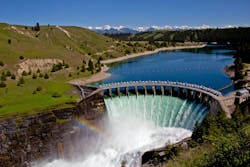Top 4 Fluid Control Breakthroughs Transforming Hydropower
What You’ll Learn:
- In this civil engineering-focused article, Emily Newton discusses how high-tech improvements can influence fluid control and related areas, spotlighting the role of valves and other components affecting fluid control, water pressure, energy conversion and additional aspects.
- How AI could bring fluid control breakthroughs by suggesting practical ways to optimize flow mechanics.
- Fluid control techniques have implications for renewable energy’s potential and support adoption rates.
Emerging hydropower technology trends emphasize the continuing relevance of using water movement as an electricity-generation method. Digital sensors, artificial intelligence and other advanced solutions help professionals achieve more than they previously could. Knowing about the leading fluid control breakthrough can inform your work and keep it relevant in a fast-paced industry.
Developing a Digital Hydropower Management Suite
Hydropower sites feature numerous valves and other components affecting fluid control, water pressure, energy conversion and additional aspects. Current performance information can help workers monitor operations and maximize outcomes.
Innovations in digital technologies have rapidly advanced the possibilities, often allowing parties to monitor multiple hydropower sites or alter their functionality from remote locations. A project with 10 European partners shows the exciting way forward when emphasizing digitalization to unlock additional potential.
READ MORE: Can Hydropower Deliver Enough Energy to Turn On the World?
This innovative platform features three specialty components encompassing various information feeds to enhance outcomes. Participants intend to test it at five operational hydropower plants. Estimates suggest the solution will cause a 5%-10% reduction in operating and maintenance costs. Additionally, the sensor data equips decision-makers to maximize generation and revenue. Because one of the new tools offers flow forecasting details, it helps leaders quickly access fluid control details. Executives can then pinpoint potential issues, such as malfunctioning valves.
These solutions also feature open, transparent and secure data-sharing protocols. When authorized users can share information across sites, it is easier for them to analyze how flow-control setups, environmental factors and additional aspects affect operations. Acting on insights allows professionals to improve statistics under their influence, compensating for those they cannot manipulate.
This solution could also influence choices made when upgrading European hydropower plants. This renewable electricity is the continent’s second-largest source, and planned enhancements keep plants maximally productive.
Improving Hydropower Inspections with Technology
Scheduled technician visits directly impact fluid control because these professionals check gates, valves and intake components. They also assess sites for leaks, which gradually degrade overall outcomes if left unaddressed. However, planned inspections only show hydropower equipment performance during a snapshot in time.
Many professionals fill visibility gaps by combining in-person checks and real-time data monitoring. A sensor on a valve or other fluid control mechanism can give immediate alerts of abnormal functionality. Investigating them reduces unwanted outcomes and allows workers to take preventive actions against operational stoppages.
READ MORE: Clean-in-Place Utilities and Automated Reporting Analytics Replace Manual Recording Tasks
Automated optical inspection is widely used in numerous industrial environments, such as manufacturing plants. Two-dimensional systems are the most effective way to find surface-level defects. Other automation advancements have furthered hydropower technology trends. For example, robots check things in tight spaces or perform tasks that are dangerous to humans. Underwater drones assess submerged components, eliminating the need for dive teams.
Some training schools also give students real-world competence for future inspections through highly detailed simulations. Because these occur in controlled environments, they are safer and more cost-effective than having everyone learn at hydropower plants. Technology does not replace all actual settings, but it is an excellent complement that lets educators expose learners to realistic content without planning travel time.
Expanding Fluid Control Options with a High-Density Project
A new pumped-hydropower initiative in Plymouth, England could change professionals’ understanding of fluid control, potentially influencing your future efforts. Engineers install them in mountainous areas because these systems traditionally use gravity to influence water movement. However, that approach significantly limits site suitability.
The results of a 500-kilowatt demonstration project could open new possibilities. It relies on a fluid called R-19 that is two-and-a-half times denser than water. It is a mineral suspension in which concrete can float.
READ MORE: Electrohydraulic Disruption: New Technologies Steer the Way Forward
A chief executive leading the project revealed that the earliest ideas for this innovation emerged eight years ago. Like many other previous efforts, problem-solving shaped its development. As the leader and his colleagues attended numerous industry conferences, they repeatedly heard presenters discuss the prominent role of storage in the world’s renewable energy transition. However, their advice solely centered on batteries.
Conversely, pumped hydropower has two reservoirs at different elevations. Energy generation occurs when water flows through turbines as it moves from one to the other. If these sites have excess power, it pumps the liquid back to the highest reservoir, preparing it for release during decreased availability from supplemental sources. This mechanism results in a stored—but readily usable—resource.
The company’s project examined the alterable equations within pumped hydropower calculations. Engineers knew they could not change gravity but investigated density-related fluid control dynamics. The professionals ultimately developed a solution that achieves comparable performance on sites with 40% lower elevations. Alternatively, using this technology in the traditionally selected mountainous areas lets people build 60% smaller systems that perform as well as their counterparts.
Optimizing Turbine Designs with Artificial Intelligence
Artificial intelligence has enabled advancements, including those that encourage engineers to explore new component configurations. Professionals from a hydropower plant manufacturer and propulsion technology institute collaborated during an AI-assisted turbine development project.
Turbines respond to water movement by turning it into energy. This team believed AI could bring fluid control breakthroughs by suggesting practical ways to optimize flow mechanics. For example, targeted adjustments to rotors or guide vanes might mitigate stress while maximizing hydraulic productivity. Although engineers have conventional techniques to enhance outcomes, they are often time-consuming and require significant trial and error.
This new approach uses machine learning to automate the steps and evaluate possibilities according to their alignment with key criteria. This software-based tool encompasses fluid dynamics, structural mechanics and various simulation models, generating possible designs for users and reducing costly calculations that can slow the process.
Early results showed this technology maintains consistent flow rates while enabling numerous operational efficiencies. Although the researchers intend to scale their innovation, these first outcomes suggested AI can shorten development time frames and improve turbine quality.
The group will take the next steps by assessing how to apply this innovation to additional hydropower components while integrating other physical disciplines. They are also running technical workshops and tailored training programs to assist peers in bringing AI technology to existing development workflows.
Monitoring Hydropower Technology Trends
These exciting advancements highlight why people interested in hydropower or working in the industry should stay aware of high-tech improvements influencing fluid control and related areas. New information raises this renewable energy’s potential, increasing its adoption rates. Even solutions never made commercially available will still teach engineers about different options, encouraging them to explore creative avenues.
About the Author

Emily Newton
Emily Newton is a technology and industrial journalist. She is also the editor in chief of Revolutionized. She has over five years covering stories about warehousing, logistics and distribution.
